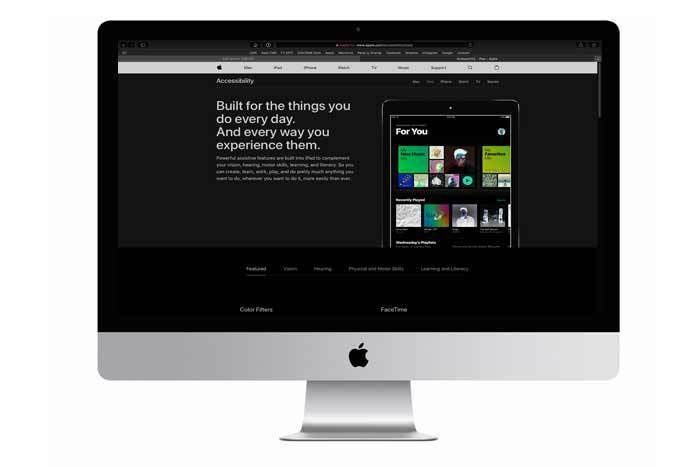WWDC 2017 Wish List: 4 accessibility features Apple needs to add to iOS and macOS

Jason Snell said it best when he wrote that WWDC is “the heart of the Apple world’s calendar.”
Apple’s Worldwide Developers Conference is particularly special for me because it’s the event where, as a person with disabilities, I get to see what lies ahead for the accessibility of Apple’s four software platforms. The company has put considerable energy in the last few years into making accessibility a focal point of the conference—from sessions on new APIs to labs to social get-togethers, Apple has gone all out during the week to show that, yes, supporting accessibility is a top priority in Cupertino at the highest levels.
With this sentiment in mind, here are four accessibility-related features I’d like to see Apple announce at next month’s keynote.
Better Dynamic Type support in the App Store
While this wishlist isn’t organized in a particular order of preference, this one has been at the top of my list for years. It’s something I struggle with and gripe over every single day.
The problem I have with the iOS App Store (and Apple’s other digital storefronts) is the majority of the text is way too small to read comfortably. Here’s an example: Cultured Code’s Things 3. I went to download the new app after reading good things about it, but I have to squint and strain my eyes in order to read the app description. I could turn on Zoom to remedy this, and I have been lately, but I would prefer Apple add pervasive support for Larger Dynamic Type.
What’s so frustrating about this is many of the headings in the App Store (e.g., the Featured page) do support Dynamic Type. It’s strange that the implementation goes only so far—larger text would make reading app descriptions, release notes, and reviews an exponentially more pleasant experience.
Dynamic Type on the Mac
The 13-inch Touch Bar MacBook Pro—and the Touch Bar’s accessibility support—reinvigorated my enthusiasm for the Mac, and I’ve been using macOS a lot more since the laptop debuted.
Similarly to the App Store, I’ve found macOS Sierra to be less than ideal in a few places in terms of visual accessibility. Text in things such as dialog boxes, System Preferences panels, and even the menu bar are all somewhat difficult to read because text size is small. Unlike on iOS, it’s not possible today to adjust text size and have it apply system-wide. And yes, I could use Zoom to make text larger. But I’d rather have the Mac gain support for Dynamic Type, It’s great and I miss it.
Dynamic Type on macOS would instantly fix my gripes with text in dialog boxes and the like. (Apple could even add to it to the Mac App Store for good measure.) And like on iOS, Apple could make Dynamic Type a public API on macOS so third-party developers like, say, Flexibits could hook it up to Fantastical. Dynamic Type makes third-party apps better too. A win-win.
Larger and Searchable Emojis on iOS
Like everyone else, I use emoji often to add color to my iMessage conversations and in my tweets on Twitter. And yet, there are two problems I have in doing so.
On the iPhone, emojis are small. Because of this, it’s tough to discern which face is making what expression. Too often I’ve accidentally chosen a wrong or inappropriate face because I couldn’t tell what it was. Exacerbating the problem is the fact the emoji keyboard itself is designed in such a way that it makes it difficult to see which category I’m in. The glyphs on the bottom are small and low contrast. (I can happily report that none of these issues are present on the Touch Bar MacBook Pro or the 12.9-inch iPad Pro. I never have trouble on those devices.)
Also, iOS is in dire need of an emoji search function. I’m in complete agreement with Jason Snell on this. Finding them really is the worst. The lack of search actually ties into the size problem—since I can’t search, I have to swipe forever while squinting to find the emojis I want to use. Not good.
Please, Apple. If the Mac has emoji search, so should iOS.
Dark Mode on iOS
For reasons of contrast and legibility, I use dark modes often on my devices. I use it on the Mac exclusively. On iOS, I use it in many third-party apps such as Twitter, Ulysses, and Overcast. Despite having contrast-changing options like Grayscale and Invert Colors, iOS is missing a dark mode. I’d like one.
While I generally don’t have any usability concerns with the amount of white space in iOS, I find that I prefer switching between “light” and dark modes depending on the time of day. Light mode during the day, dark mode at night. In the case of Ulysses, I like using dark mode all the time because I think it looks nicer and, functionally speaking, it makes it easier for me to track Markdown syntax as I’m writing.
I like to think the white-on-black aesthetic of the Apple Watch companion app on iPhone is a harbinger of a future dark mode. I hope I’m right. Aesthetically and functionally, I really like it. If iOS gets a system-wide dark mode, I’d switch instantly.


